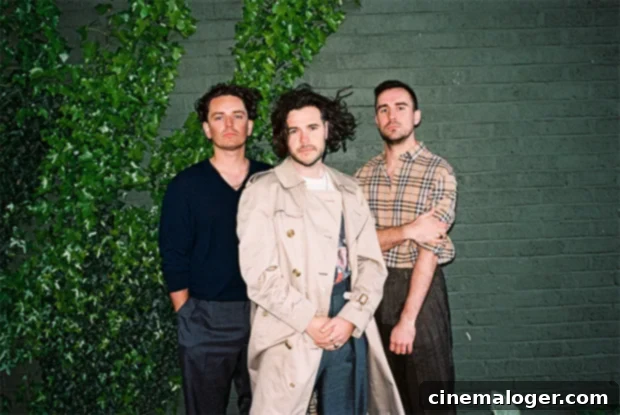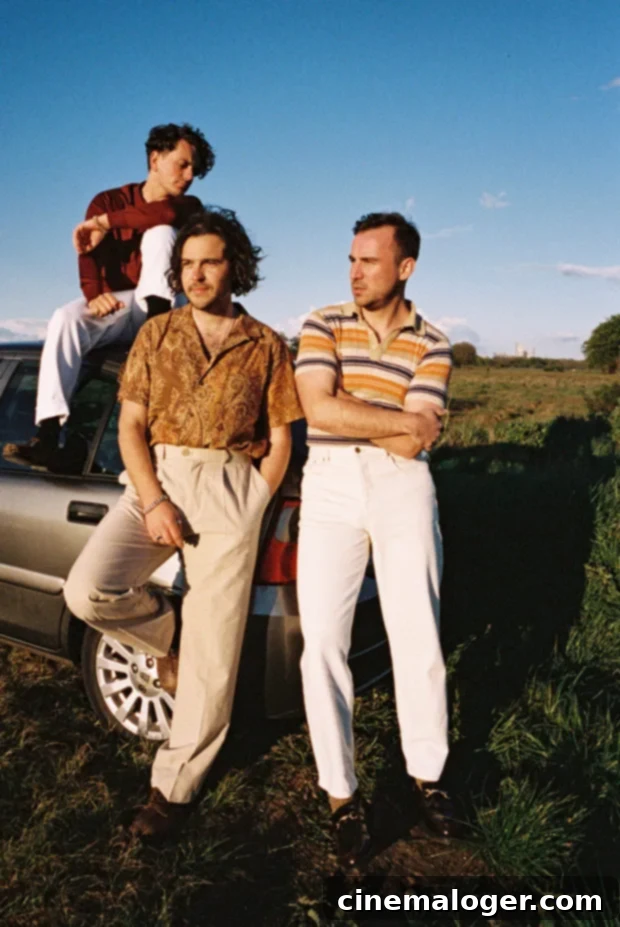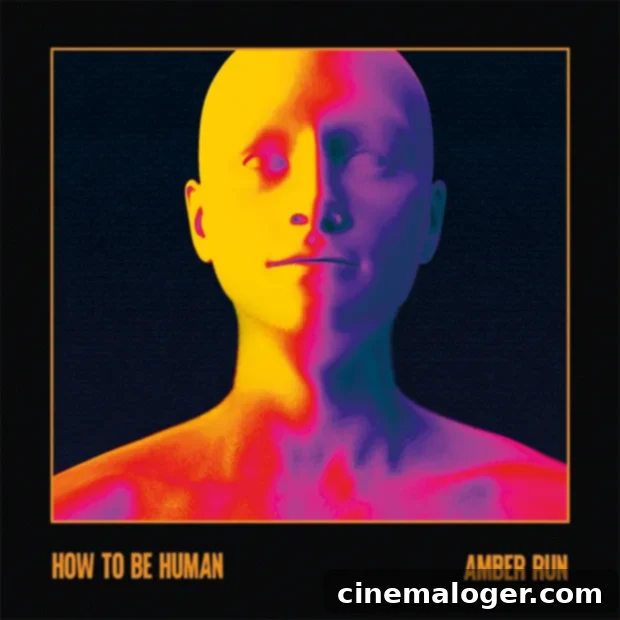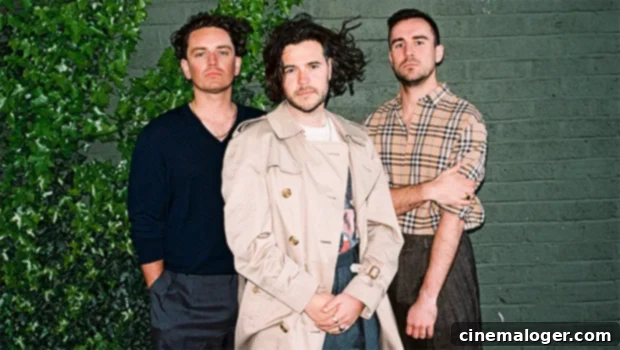Amber Run’s ‘How To Be Human’: Joe Keogh Unpacks Guilt, Growth, and the Enduring Essence of Humanity in Their Transformative New Album
In an era where artificial intelligence is rapidly blurring the lines of human capability, from ChatGPT passing law exams to David Guetta crafting tracks with AI-generated Eminem vocals, the fundamental question of “what it truly means to be human” has never been more pertinent. This profound inquiry serves as the beating heart of Amber Run’s highly anticipated new album, How To Be Human. Set to release on February 24th via TRIPEL, this record marks the indie rock trio’s first full-length project since 2019’s critically acclaimed Philophobia, signaling a significant evolution for the band.
Comprising vocalist and guitarist Joe Keogh, bassist Tomas Sperring, and keyboardist Henry Wyeth, Amber Run delves into the weighty tapestry of human existence. The album bravely navigates themes of guilt, pain, loss, death, dread, and ultimately, joy and connection. Through this introspective journey, the band has not only crafted some of the most compelling and sonically rich music of their career but also rediscovered a profound sense of purpose and enjoyment in their creative process. Keogh, speaking exclusively to HollywoodLife, reveals how the album became a vehicle for personal liberation, helping him “throw off the guilt” of past decisions and embrace the complexities of being human.
Embracing the Human Condition: Guilt, Loss, and Redemption
The album’s title, How To Be Human, is a direct reflection of its thematic core. Death, an inescapable and fundamental aspect of life, is a recurring motif, explored both in its stark finality, as hinted by a track like “Funeral,” and in the transformative process of learning to let go, adapt, and grow. This exploration allowed Keogh a deeply personal reckoning. “Making this record helped throw off the guilt of decisions I personally had made years before,” he shared. “It helped me take responsibility and ownership of my mindset at the time. It was a pleasure and a privilege to jump into it all with my closest friends. I’ll be forever grateful for the care and support we all gave each other through the process of making this record.”
This candid reflection underscores the therapeutic power of art and collaboration. For Keogh and Amber Run, the album wasn’t merely a collection of songs; it was a collective act of introspection and mutual support. The shared experience of confronting difficult emotions and past burdens within the creative sanctuary of the band allowed them to forge stronger bonds and emerge with a clearer sense of self. This journey of self-discovery extended beyond individual introspection, prompting the band to reconnect with the foundational joy of music creation.
When asked about the most significant revelation he gleaned from the recording sessions for How To Be Human, Joe’s response was refreshingly simple yet profound: “That making music should be fun. That you should be laughing the entire time. Either that what you’re saying is so true that it’s funny or that what you’re making is so good that you can’t believe it’s yours.” This shift in perspective, prioritizing joy and authenticity over external pressures, fundamentally reshaped their approach and is palpable throughout the album’s vibrant soundscape.

A Sonic Tapestry: Eclectic Influences and Distinctive Sound
This revitalized focus on joy and authentic expression is vividly evident in the musicality of How To Be Human. The album shines as a clear, expansive sonic presentation of the trio’s diverse influences and individual artistry, providing a dynamic snapshot of who Amber Run is, was, and is evolving to be. Joe elaborated on their musical philosophy: “We are all big music fans, and the taste is pretty eclectic. Our normal rule is if it’s good, it’s just good, regardless of genre or motivation.” This open-minded approach allows them to draw from a broad palette without being confined by stylistic boundaries.
Listeners will find a rich blend of genres woven into the fabric of How To Be Human. Elements of classic indie rock blend seamlessly with the dreamlike textures of bedroom pop, the introspective moods of alternative, and the raw energy of post-punk. Keogh specifically highlighted the distinctive bassline on “The Beautiful Victorious,” a moment he cherishes. “Thank you for thoughts on ‘The Beautiful Victorious,’” Joe remarked, “That was pretty much exactly what we were going for!” The mention of a “Peter Hook-ish” bassline immediately conjures images of iconic post-punk pioneers like Joy Division and New Order, demonstrating the band’s appreciation for foundational artists while carving their own path. However, the album is far from a mere pastiche of influences; it is a genuine representation of the group’s collective experiences, perspectives, and emotional landscapes.
Amber Run’s roots in live music and energetic performances also inform their sound. “We grew up going to a ton of punk, hardcore, and rock shows and we wanted a track that took the sensibility that ‘the live show is all that matters,’” Joe explained. This translates into a desire for visceral, impactful sound, characterized by “that four to the floor, dynamic thump in the chest.” While artists like The National, Bon Iver, and Arcade Fire have undeniably played significant roles in shaping the collaborative chemistry and expansive soundscapes of Amber Run, Keogh stresses the importance of maintaining their unique identity: “we try not to follow their interpretations too rigidly, or we’d lose what makes our band our own!” This commitment to originality ensures that while their inspirations are apparent, the final product is distinctly Amber Run.

The Journey Between Albums: EPs, Evolution, and Rediscovering Innocence
While How To Be Human marks Amber Run’s first full-length album in four years, the band has been far from static. The interim period was marked by a prolific output of music, including a trio of expansive EPs: The Search (Act I), The Start (Act II), and The Hurt (Act III), alongside a handful of compelling singles. These releases were not just placeholders but crucial stepping stones that allowed the band to experiment, grow, and reconnect with their creative core without the pressure of a traditional album cycle. “We are enjoying making music, and it’s difficult not to do something that you’re enjoying,” Joe reflected, emphasizing the newfound freedom in their process.
This period allowed Amber Run to shed the weight of industry expectations and rediscover the pure joy of creation. “We aren’t thinking about release schedules, deadlines, or industry standards anymore,” Joe elaborated. “We are trying to write songs and then record and release them in the moment they were conceived. The whole project feels innocent again – like it did when we first started.” This organic, spontaneous approach to songwriting and release has undoubtedly contributed to the authentic and heartfelt quality of How To Be Human, making it feel fresh and unburdened by external pressures.
Personal Growth and the Enduring Value of Past Art
The time between Philophobia and How To Be Human has also brought significant personal milestones for the band members, particularly for Joe Keogh, who became a father. Such transformative life experiences often lead artists to view their older work through a different lens, sometimes creating an emotional disconnect. However, Keogh maintains a strong connection to Amber Run’s earlier material. “I personally don’t find it difficult to connect with the older music because: 1. I like it; 2: I’m proud of it; 3: they themselves are little mementos of moments in time,” he shared.
He views past material not as a separate entity but as an integral part of their ongoing artistic narrative, a foundation upon which new creations are built. “The past material helps inform and inspire the next bunch of stuff. What worked for us? What didn’t? Why?” This continuous dialogue with their own history allows for growth and refinement. Keogh also offers a valuable insight into artistic creation: “And fundamentally, we are trying to say stuff that’s important to us, but we are just pushing air. I find if you take it all too seriously then you’ll struggle to get to the real motive of what you’re trying to say. The ‘gravitas’ and the pressure stifles the process.” This philosophy of not overthinking or over-pressuring the creative act is crucial to maintaining authenticity and allowing the core message to shine through.

The Paradox of Timelessness and the Human Touch in Art
Keogh’s perspective on the enduring value of older expressions is rooted in a nuanced understanding of music as both a static preservation of a moment and an evergreen, timeless expression. He believes these two concepts are not mutually exclusive. “I don’t believe those two statements are opposite,” he asserted. “None of us are that different from one another. So what I’m experiencing now will probably not be that different from someone else in 50 years that is going through a similar moment.” This idea of shared human experience across generations is central to how art connects people.
He further elaborated on the pitfalls of explicitly striving for timelessness: “As previously mentioned, reaching for timelessness may inadvertently stop you from achieving it – because you’re so busy trying to make it great that you forget to sprinkle any humanity. But that’s just me and how we go about it.” This insight suggests that true timelessness often emerges organically when artists focus on genuine human expression and connection, rather than an abstract ideal of greatness. It’s the vulnerability, the flaws, and the relatable emotions that resonate through time, not just technical perfection.
A Lingering Question: The Unfolding Mystery of Life
After such a profound exploration of “how we go about” being human, confronting personal guilt, embracing joy, and navigating the complexities of life and death through their music, Joe Keogh still carries a fundamental, lingering question about this grand process we call life.
“Is there more to all this?” he ponders. “Are we missing something?”
These questions serve as a poignant reflection of the album’s core themes and the ongoing human quest for meaning. As Amber Run invites listeners to delve into their latest offering, they are also encouraging them to embark on their own introspective journeys. Fans are ultimately left to deduce the answers to these profound questions for themselves, armed with the evocative soundscapes and thoughtful lyrics of Amber Run’s new work. Amber Run’s highly anticipated album, How To Be Human, will be available on all streaming services starting February 24th, offering a powerful soundtrack to the shared human experience.
